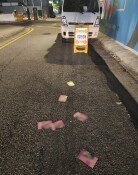Geonbongsa

A single road leads to the Geonbongsa, surrounded by forests. As soon as you get out of the car parked on the lot, the garbling brook and the chilly, piercingly pure air rushes to greet you.
The stream splits the temple site in two and the road sticks to the left. Following that path, a huge portal stands on four stone pillars. A solemn verse that reads, The heart of those who follow Buddha can only be one, is inscribed on it.
If you walk the forest trail, youll come to a rainbow-shaped stone bridge, called Neungpa. It connects the Hall of Paradise on the left side of the gorge, the Palsangjeon, which was ruined during the Korean War, and the main sanctuary and Yeumbuljeon on the right side facing north. Neungpa stands for the words of Buddha that overcame pain in a suffering world.
The two rock pillars that are at the end of the bridge have five symbols engraved upon them. They are the ten Paramitas, the exercises one must do in order to transcend the worldly desires and reach nirvana. The inner sanctuary faces the temple court accessible through a passage.
Geonbongsa was once a great temple, one of the top four temples in Korea up until the 1930s. Now it has become a branch temple of the Shinheungsa in Mt. Seorak, but back in those days it was the main temple of Shinheungsa and Naksansa. The scale of Geonbongsa was fantastic, and it became famous as the site for government affairs during historical wars as one of the two sites in the world other than Sri Lanka to possess the remains of Buddha, and as the place of never-ending Amitabha prayers for 28 years.
There are two places within the temple that hold the said remains, one being next to the inner sanctuary and the other across the gorge. They lay enshrined, with many trips across the seas due to thievery, during which some four shrines were lost.
Legend tells it that one thief who robbed the shrine is said to have turned himself in because of a dream he had in which an elderly man predicted terrible fortunes for the thiefs descendants if he did not return the stolen treasure.
The Geonbongsa valley is turning point for Mt. Geumgang. Until 1989, when the civilian passage restriction line was moved to the back of the temple, Geonbongsa became untouchable. Even the south boundary rail line runs 4.0 kilometers north of the temple, and the demilitarized zone where wild goats roam is not far away.
There is a single road where you can see Geonbongsa at a glance, and its at the Deunggongdae which is just one kilometer away. This mountain peak with its gorgeous view is where a famous monk exercised his self-disciplines in 758. When you pass the restriction line, cross the forefront base onto the trail with danger signs of mines, and youll find wildflowers and wild berries to your hearts delight.
The most impressive attraction of Geonbongsa is its fallen temple site, where wildflowers coat the broken boulders. At the top of the Jeokmyeolbogung, the ruins of Palsangjeon stand between two ponds where lotus flowers blossom. This ancient temple with 1,500 years of history behind it gives out an aura of peace and beauty.
Seung-Ha Cho summer@donga.com







